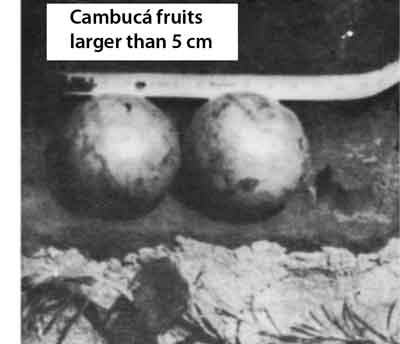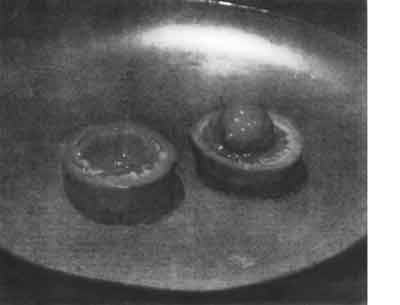
CAMBUCÁ, A MYRTACEAE AT ITS BEST
SCIENTIFIC NAME: Marlierea edulis
FAMILY: Myrtaceae
Among the numerous, native Myrtaceous fruits from Brazil, there are many that are distributed around the tropical parts of the world, such as the Guava, the Feijoa, the Pitanga (Brazilian cherry), the Jaboticaba, the yellow Jaboticaba, the Grumichama, the Pitomba and the Rio Grande cherry.
Nevertheless, the Cambucá, a superior fruit in my opinion, was unreasonably forgotten by the first foreigner explorers despite its qualities, as the well-balanced sweet-acid flavour, the soft texture, the medium fruit size, the high pulp content and the large fruit yield.
Even in Brazil, there are very few people who know it. We can find some trees called "Cambucaseiros" in only a few rare fruit growers' orchards and in some botanic gardens. It was a very usual fruit at the Rio de Janeiro markets 60 years ago, but today, it has disappeared due to devastation of its natural environment.
Its name came from the Tupi Indian word 'kabu ká', which means 'The bud plant' (maybe due the cauliflower aspect). Its adopted scientific nomenclature is Marlierea edulis Ndz. (Eugenia edulis Veil. and Rubachia glomerata Berg as synonym).
Plant Description
The Cambucá is a very slow-growing, evergreen tree, reaching usually from 5 to 12 m high. The short trunk (30% of the total height), 30 to 50 cm in diameter, has a wide and dense crown of slender, spreading branches. As many other plants from its family, it has a smooth, thin, pale brownish-gray outer bark easily peeled off in large flakes to show the coppery layer below.
On the short (5-15 mm), finely hairy, petioles there are evergreen, opposite, elliptic-acuminate, leathery, glossy, curled margin leaves, 5- 16 cm long, 3-5 cm wide, glabrous, dark green above and slightly downy, light green below. The round flower buds are 3 mm in size. The sessile white flowers, with a cluster of numerous stamens 10 mm long, are borne agglomerated in groups (2-8 flowers) over the axils of the branches or distributed around the stem.

The very smooth, short-stalked, globular berry is larger than most Myrciarias and Eugenias. They are green at the beginning, turning yellow to bright orange-yellow when ripe, presenting many slightly raised, longitudinal ridges. Some old books mention the existence of fruits 6 to 9 cm large, but the trees that I know produce smaller fruits. Their size ranges from 5.0 to 5.4 cm in diameter and 4.2 to 4.5 cm in height and their weight from 55 to 70 g. Under the leathery, thin skin, there is a soft, grainless, juicy, orange-yellow, 0.4-cm-thick flesh, similar to Peaches in texture. It involves an incredibly delicious, translucent, melting, yellow, 0.8 cm thick pulp that encloses one or rarely (5%) two hard, oblong, flattened, light purple seeds, easily separable from the pulp. Both, flesh and pulp, have a delicious, well-balanced subacid to sweet flavour, resembling Jaboticabas, Grumichamas and Pitombas, but without any trace of astringency or resinous aftertaste.
Distribution and Climatic Requirements
The Cambucá is native from the Brazilian southeast coast, between parallel 21° and 24° south in Rio de Janeiro and Sao Paulo states. It is a very narrow area surrounded by the Atlantic ocean and the "Serra do Mar" mountain ridge.
This is a very hot and rainy region with temperatures between 9 and 42° C and annual rainfall around 2,000 mm. However, this plant can be very well-adapted to many different climates. There are well-developed and good bearing trees in colder places as Petropolis, over the hills around Rio de Janeiro (850 m in elevation and minimum temperature around 0° C) and Porto Alegre, situated 30° south and with temperatures ranging from -1 to 40° C. In dryer places, such as Campos or Piracicaba (annual rainfall < 1,200 mm), well-established trees can tolerate as much as 2 months of drought without irrigation. The tree thrives well in Recife, located at 8° south to the equator.
There is very little information about the existence of specimens growing outside Brazil. To my knowledge, it is an unknown fruit in the United States. Some specialized books give a very little information, using no more than 5 lines to describe it.
The seeds I sent last February to Australia (Lidcombe - 34° south), to Mr. Hans Muller, are growing well after 8 months. They proved to be cold hardy during the last winter. There are some young seedlings growing in Florida and Hawaii also.
Propagation and Culture
The Cambucá is generally propagated by seeds. They remain viable for no more than one week when kept dried or three weeks when preserved in moist sawdust or sphagnum moss.
Seeds must be covered with a 0.5 to 1.0 cm layer of good soil and watered 2 times per day. They start to sprout in 2 to 5 months with 80% of success. Most of them are polyembryonic, producing up to 5 or 6 air shoots. Only the strongest must be maintained. The seed bed must be protected from the sun and wind during the seedling growth. Usually they are planted 8 m apart, 10 - 12 months after germination, when they are 40 - 50 cm high.
Marlierea edulis prefers a deep, rich, well-drained soil and supports full sun. It is a very slow-growing plant. Trees 5 and 10 years old, are just 1.0 - 1.5 m and 2.0 - 3.0 m high, respectively. Young trees must be pruned to maintain the trunk clear up to about 70 cm.
There is low variation in fruits when growing from seeds, meaning no selected cultivars and minimizing the necessity of vegetative propagation methods. Seedlings commonly begin to flower and bear in 10 years. There isn't any known method of reproduction which can reduce this long time but, probably, the methods used in Jaboticaba culture will be successful.
Fertilization may be done distributing 500 - 800 g per year of mixed fertilizer (N:P:K ratio 10:10:10). When they start bearing fruits, it is recommended to make 2 or 3 annual applications (800 g each) of 10:5:10 mix. The tree usually produces large crops. A 40-year-old tree produced more than 500 fruits last summer without fertilization but with its roots watered continuously by a side stream of clear water. The Rio de Janeiro Botanic Garden, has a productive tree that is more than 80 years old.
Season and Harvesting
In Rio de Janeiro, flowering occurs from late October to December. The fruit ripening happens during December and January, when their colour changes from green-yellow to yellow and orange-yellow. At the last stage, they start to fall on the ground, generally bruising the skin.
The best time to pick the fruits is during the yellow stage when they can be stored for up to 1 week at 25° C, maintaining their flavour with full quality without overriding problems. At the orange-yellow stage, the fruits reach full maturity and the external flesh turns softer, but they become very perishable.
Pests and Diseases
The main disease is the rust caused by fungus (Puccinea cambucae and Uredo navidula) that covers many parts of the plant with a red-golden dust of beautiful aspect. They are easily controlled. Occasionally, some trunk borer (Cratosomus undabundos and Stenoma albella), usual in other native Myrtaceae, makes holes under the bark and long galleries downward inside the branches requiring control practices. Sometimes, a leaf caterpillar (Chrysomphalus aonidum) may attack the plant.

Fortunately it presents another advantage unlike most native Myrtaceae. Its harder skin prevents any fruit fly attack.
Uses
The tree is very ornamental due to its dense canopy and the decorative effect when setting their fruits.
Leaf and seed decoctions are used in homeopathic formulations against bronchitis and coughs. The astringent bark can be used in the leather industry.
The resistant, elastic, fairly heavy (d = 0.91 g/cm3), light brown wood, is adequate to make small tools and furniture.
Fully ripe Cambucás are prized to eat out of hand. We need just to take a knife and cut around the middle of the fruit to reach its delicious, natural jelly-like, internal pulp with a spoon. The external flesh may be used to make jams, marmalades and pies. Both are used to make juices and ice-creams rich in flavour and colour.
Their composition is given below:
| Fruit Composition | |
|---|---|
| Calories | 66 |
| Protein | 1.7 g |
| Calcium | 21 mg |
| Phosphorus | 22mg |
| Iron | 2.3mg |
| Vitamin A | 0.03 mg |
| Vitamin B1 | O.04mg |
| Vitamin B2 | 0.04mg |
| Vitamin C | 33mg |
Photos by Antonio Luiz Morschbacker
DATE: November 1993
* * * * * * * * * * * * *
